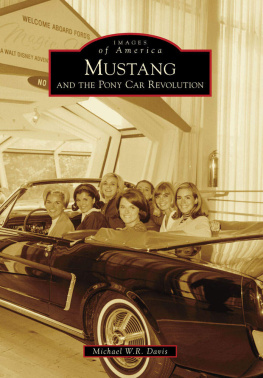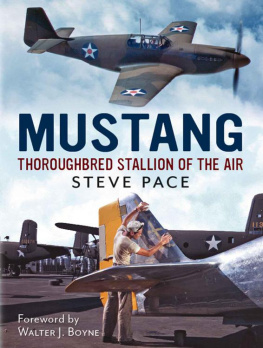BOSS
MUSTANG
50 YEARS
DONALD FARR
FOREWORD BY KEVIN MARTI

FOREWORD BY KEVIN MARTI
I n the automotive world, Mustang is one of the most recognized brands. Within the Mustang world, Boss is one of the most powerful words. And within that Mustang world, Donald Farr is one of its most recognized authorities. He has penned more words on the Mustang in his illustrious career than most of us will ever write in our lifetimes.
I dont establish friendships lightly. Mine are developed with people I admire and respect. Traits such as humility, knowledge, genuineness, and enthusiasm are core to those individuals. In these pages, you will meet Donald and discover what I did those many years ago: his expertise is as deep as his spirit.
His first book on the 19691970 Boss 302 Mustangs, published in 1983, has appreciated in value, much like the cars he writes abouta true testament to the value of his work.
All the drive, all the mistakes, all the edginess, all the triumphs float off these pages and into your mind as you read this book. You can hear the crowds scream; smell the rubber burn; feel the crunch of a race car hitting the wall; sense the determination, then the silence. Four decades later, the sound of hoofbeats (or is it that crazy quad exhaust?) echoed again. The Boss was back! See history repeat itself. Watch lightning strike twice.
This revised and expanded edition of Donalds Boss 302 history from 2011 takes you from the fever-pitched design centers to the hallowed race tracks, and is now bolstered by the over-the-top Boss 429 Mustang. Ford figured out how to stuff the Boss 429 into the Mustang; in like manner, Donald has now wedged the Boss 429 story into this book.
There are two time periods associated with the Boss Mustangs: the late 1960s and the early 2010s. Both contain compelling histories of individuals with grit and determination, fierceness and ambition. And you will see how Ford made outrageous acceptable with these cars.
Shinoda, Shelby, Jones, Follmer, Moore, Farley, Pericak. They and a host of others brought the Boss Mustangs to life. Here, Donald brings that Boss life to you.

Parnelli Jones won three of the first four races to give Ford a big lead in the 1970 Trans-Am points standings. Ford Motor Company Photo
CHAPTER 1
19631968: FORD GOES RACING
S emon E. Bunkie Knudsen liked performance and racing. As Pontiac general manager between 1956 and 1961, Knudsen transformed the old lady division of General Motors into the third largest automotive division in America, behind Chevrolet and Ford. He began by scrapping Pontiacs traditional Indian head hood ornament and proceeded to add bigger engines and modern suspensions. He fired entrenched management personnel and hired two bright engineers, Pete Estes and John Z. DeLorean, who would later be instrumental in dropping a 389-cubic-inch engine into the midsize 1964 Tempest and calling it the GTO. That Little GTO created a new genre of American automobile that became known as the muscle car.
Pontiacs image change was backed by a massive GM effort in stock car racing. Knudsens NASCAR charge led GM, and eventually Ford and Chrysler, out of a four-year-old Automobile Manufacturers Association racing ban, an agreement between the Big Three that prohibited any form of factory-backed racing or the advertisement of horsepower or engine displacement for the purpose of selling cars. It was Pontiacs success in stock car racing, including a NASCAR-record 30 wins in 1961, that kick-started Ford into a new Total Performance campaign.
In late 1960, Lee Iacocca ascended to general manager of Ford when Robert S. McNamara left to become President John F. Kennedys secretary of defense. While the move led to Fords assault on racing in the mid-1960s, Iacocca also pushed for a sporty Falcon-based car called the Mustang. Recognizing the emerging baby boom market, Iacocca realized that the way into youthful wallets was through sportier cars and racing. Under Iacocca, Fords Total Performance program exceeded Pontiacs early efforts and would, within just a few years, propel Ford to the top of world-class racing.
After embarrassing NASCAR finishes in 1961 and 1962 (totaling just 13 wins for both years), Ford rebounded to win 23 races in 1963, a record-tying 30 in 1964, and an amazing 48 in 1965. In sports car racing, Iacoccas Total Performance budget spilled into California, where an exchicken farmer named Carroll Shelby had molded an orphaned AC Ace into the Ford-powered Cobra. In 1964 Cobras proved their racing worth by winning the United States Road Racing Club (USRRC) manufacturers title and dominating the Sports Car Club of America (SCCA) A Production class. With proven racing successes, Shelby eventually inherited Fords struggling GT-40 program and turned it into back-to-back wins at Le Mans.
By the end of 1966, Ford-powered cars had captured the World Manufacturers Championship, beaten Ferrari at Le Mans, won the Indianapolis 500, dominated Formula 3 racing, and captured the inaugural Trans-American Sedan Championship.
For the man on the street, Fords racing achievements filtered down in the form of high-performance equipment and engines. Shortly after Iacocca announced his Total Performance campaign, Ford introduced the 390 High Performance engine, a 375-horsepower version of the FE big-block that evolved into the legendary 427. At Shelby, the Cobras success convinced Iacocca that Shelby American should handle the Mustangs first foray into sports car racingand the Shelby GT350, the first of the pony-sized muscle cars, was born. It was the beginning of something big for Mustang.
Recognizing the emerging baby boom market, Iacocca realized that the way into youthful wallets was through sportier cars and racing.
Thanks to his racing success with Cobras, Carroll Shelby was asked to turn the Mustang into a sports car for SCCA racing. The result was the GT350, seen here as a competition model. Ford Motor Company Photo
Carroll Shelby led Ford back to racing prominence with his 289 Cobras, which dominated sports car racing in 1963 and 1964. Ford Motor Company Photo
Trans-Am Mania
On March 25, 1966, the SCCA staged its first Trans-American Sedan Championship race as a preliminary event to the 12 Hours of Sebring. Created as a manufacturers championship to take advantage of the popularity of sedan road racing, not to mention the popularity of the new Mustang and Barracuda, the Trans-Am featured two classes: one for cars with engines under 2 liters and another for cars with up to 5-liter (305-cubic-inch) engines. As a series based on production vehicles, one of the rules stated that eligible models had to be built in quantities of at least 1,000, a homologation requirement that would play a role in the future of Trans-Am and pony car performance.













